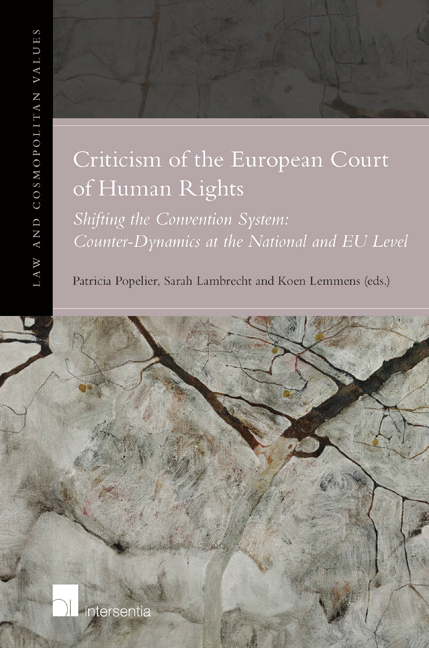 Criticism of the European Court of Human Rights
Criticism of the European Court of Human Rights Book contents
- Frontmatter
- Contents
- List of Abbreviations
- PART I INTRODUCTORY
- PART II SPARSE CRITICISM
- PART III MODERATE CRITICISM
- Chapter 11 France: “Jet'aime, moi non plus”
- Chapter 12 Hungary: ‘Gains and Losses'. Changing the Relationship with the European Court of Human Rights
- Chapter 13 The Netherlands: Political Dynamics, Institutional Robustness
- Chapter 14 Norway: New Constitutionalism, New Counter-Dynamics?
- Chapter 15 Switzerland: The Substitute Constitution in Times of Popular Dissent
- Chapter 16 Turkey: The European Convention on Human Rights as a Tool for Modernisation
- PART IV STRONG CRITICISM
- PART V HOSTILE CRITICISM
- PART VI SYNTHESIS
- APPENDIX
Chapter 14 - Norway: New Constitutionalism, New Counter-Dynamics?
from PART III - MODERATE CRITICISM
Published online by Cambridge University Press: 13 December 2017
- Frontmatter
- Contents
- List of Abbreviations
- PART I INTRODUCTORY
- PART II SPARSE CRITICISM
- PART III MODERATE CRITICISM
- Chapter 11 France: “Jet'aime, moi non plus”
- Chapter 12 Hungary: ‘Gains and Losses'. Changing the Relationship with the European Court of Human Rights
- Chapter 13 The Netherlands: Political Dynamics, Institutional Robustness
- Chapter 14 Norway: New Constitutionalism, New Counter-Dynamics?
- Chapter 15 Switzerland: The Substitute Constitution in Times of Popular Dissent
- Chapter 16 Turkey: The European Convention on Human Rights as a Tool for Modernisation
- PART IV STRONG CRITICISM
- PART V HOSTILE CRITICISM
- PART VI SYNTHESIS
- APPENDIX
Summary
CRITICISM OF THE EUROPEAN COURT OF HUMAN RIGHTS
Norwegian criticism on the European Court of Human Rights (the ECtHR or the Court) is strongly connected to the impact of the European Convention on Human Rights (the ECHR or the Convention) in Norwegian law. In particular since around 2000, the impact of the ECHR has grown because of the increased formal status of the ECHR in Norwegian law and the expanding case law and dynamic interpretation of the Court (both in cases against Norway and in cases against other Member States). The increased impact has led to increased criticism of both the ECtHR and the Convention system.
Norway was among the first countries to sign and ratify the ECHR. But even though Norway is considered a fierce supporter of human rights, it was not a fierce supporter of the ECtHR during the drafting of the Convention. Norway argued against the establishment of the ECtHR. And when it became clear that the ECtHR was to be established, Norway was among the countries who argued for granting the ECtHR only weak remedial powers – including no power to invalidate domestic legislation. Norway accepted the jurisdiction of the ECtHR in 1964, but only after considerable debate at the national level.
Norway has a dualistic system. International conventions need an act of implementation to become part of Norwegian law. Such an act can take three forms: Active transformation (the recital method), incorporation (the reference method) and passive transformation (a simple finding of conformity between existing Norwegian law and the international obligations). When the Convention was ratified, a passive transformation was deemed sufficient. Norway perceived itself as a well-functioning and democratic state that would not violate human rights and the Convention was mainly thought to protect against the (re-)establishment of authoritarian and suppressive regimes. Further, the first case in which Norway was found to violate the Convention by the ECtHR only came in 1990. And until then Norwegian courts had only sporadically dealt with the Convention, and mostly as an argument in support of a solution achieved through other sources of law.
- Type
- Chapter
- Information
- Criticism of the European Court of Human RightsShifting the Convention System: Counter-dynamics at the National and EU Level, pp. 361 - 384Publisher: IntersentiaPrint publication year: 2016
